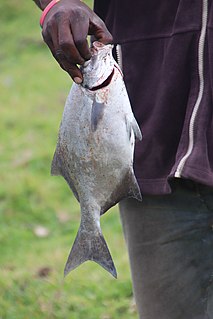
The African penguin, also known as the Cape penguin or South African penguin, is a species of penguin confined to southern African waters. Like all extant penguins, it is flightless, with a streamlined body and wings stiffened and flattened into flippers for a marine habitat. Adults weigh an average of 2.2–3.5 kg (4.9–7.7 lb) and are 60–70 cm (24–28 in) tall. The species has distinctive pink patches of skin above the eyes and a black facial mask. The body upperparts are black and sharply delineated from the white underparts, which are spotted and marked with a black band. The pink glands above their eyes help them with thermoregulation. To cope with changing temperatures, blood is sent to the glands to be cooled by the air.

Adam Craig Gilchrist is an Australian cricket commentator and former international cricketer and captain of the Australia national cricket team. He was an attacking left-handed batsman and record-breaking wicket-keeper, who redefined the role for the Australia national team through his aggressive batting. Widely regarded as the greatest Wicket-keeper-batsman in the history of the game, Gilchrist held the world record for the most dismissals by a wicket-keeper in One Day International (ODI) cricket until it was surpassed by Kumar Sangakkara in 2015 and the most by an Australian in Test cricket.

Zantedeschia is a genus of eight species of herbaceous, perennial, flowering plants in the family Araceae, native to southern Africa from South Africa north to Malawi. The genus has been introduced on all continents except Antarctica. Common names include arum lily for Z. aethiopica and calla and calla lily for Z. elliottiana and Z. rehmannii, although members of the genus are neither true lilies of Liliaceae, true Arums, nor true Callas. The colourful flowers and leaves of both species and cultivars are greatly valued and commonly grown as ornamental plants.

Phoronids are a small phylum of marine animals that filter-feed with a lophophore, and build upright tubes of chitin to support and protect their soft bodies. They live in most of the oceans and seas, including the Arctic Ocean but excluding the Antarctic Ocean, and between the intertidal zone and about 400 meters down. Most adult phoronids are 2 cm long and about 1.5 mm wide, although the largest are 50 cm long.
Phoronopsis is a genus of horseshoe worm in the family Phoronidae, in the phylum Phoronida. The members of the genus live in tubes at the bottom of the sea.
Phoronopsis californica is a species of marine horseshoe worm in the phylum Phoronida. It was first described as a new species by William Hilton in 1930 when he found it at Balboa Bay in Newport Beach, California.

The stone bream is a species of marine ray-finned fish, a sea chub from the family Kyphosidae, which is native to the Indian Ocean coast of Africa where it can be found along rocky coasts from Mozambique to South Africa. This species grows to a length of 50 centimetres (20 in) SL though most do not exceed 18 centimetres (7.1 in). The greatest recorded weight for this fish is 2.6 kilograms (5.7 lb). This species is commercially important and is also popular as a game fish. This species is the only known member of its genus.
John Dow Fisher Gilchrist (1866–1926) was a Scottish ichthyologist, who established ichthyology as a scientific discipline in South Africa. He was instrumental in the development of marine biology in South Africa and of a scientifically based local fishing industry.
Phoronis ovalis is a species of marine horseshoe worm in the phylum Phoronida. It is found in shallow waters in the northeastern Atlantic Ocean, the southeastern Atlantic Ocean, Argentina, and other scattered locations worldwide. These worms secrete a tube into which they can retreat, and burrow into the shells of molluscs.
William Wardlaw Thompson was a South African ichthyologist and zoologist. It is known that he was educated at the South African College in Cape Town between 1858 and 1863 and that he obtained a post on the civil service of the Cape Colony in 1877 in the Railway Department as a temporary clerk. In January 1878 he secured a permanent post as a clerk in the Public Works Department, where he was promoted to First Clerk in 1882. In January 1885 he was transferred to the position of Chief records Clerk at the Crown Lands Office being promoted in July 1889 to first class clerk at the Department of Agriculture attaining the post of acting chief clerk there in November 1897. Prior to this he had taken and passed his Civil Service Law examinations and he also served with the Duke of Edinburgh's Own Volunteer Rifles in the Transkei during the 9th Frontier War in February to May 1879 and in Basutoland in September 1880 to March 1881 during the Basuto Gun War. Thompson was appointed to the Cape Colony's Fisheries Board in October 1897.
Persicula albomaculata is a species of sea snail, a marine gastropod mollusk, in the family Cystiscidae.
Phoronis embryolabi is a species of marine horseshoe worm in the phylum Phoronida. It is found in the Vostok Bay, where it lives together with Nihonotrypaea japonica, an Axiidea shrimp species, in its burrows.
Phoronis emigi is a species of marine horseshoe worm in the phylum Phoronida. It is found off the coast of Japan and is morphologically similar to Phoronis psammophila.
Phoronis hippocrepia is a species of marine horseshoe worm in the phylum Phoronida.
Phoronis ijimai is a species of marine horseshoe worm in the phylum Phoronida.
Phoronis muelleri is a species of marine horseshoe worm in the phylum Phoronida.
Phoronis pallida is a species of marine horseshoe worm in the phylum Phoronida.
Phoronis savinkini is a species of marine horseshoe worm in the phylum Phoronida. It is found in the Gulf of Tonkin. The holotype was collected off the coast of Vân Đồn District, Quang Ninh Province in northern Vietnam.
Phoronopsis harmeri is a species of marine horseshoe worm in the phylum Phoronida.




